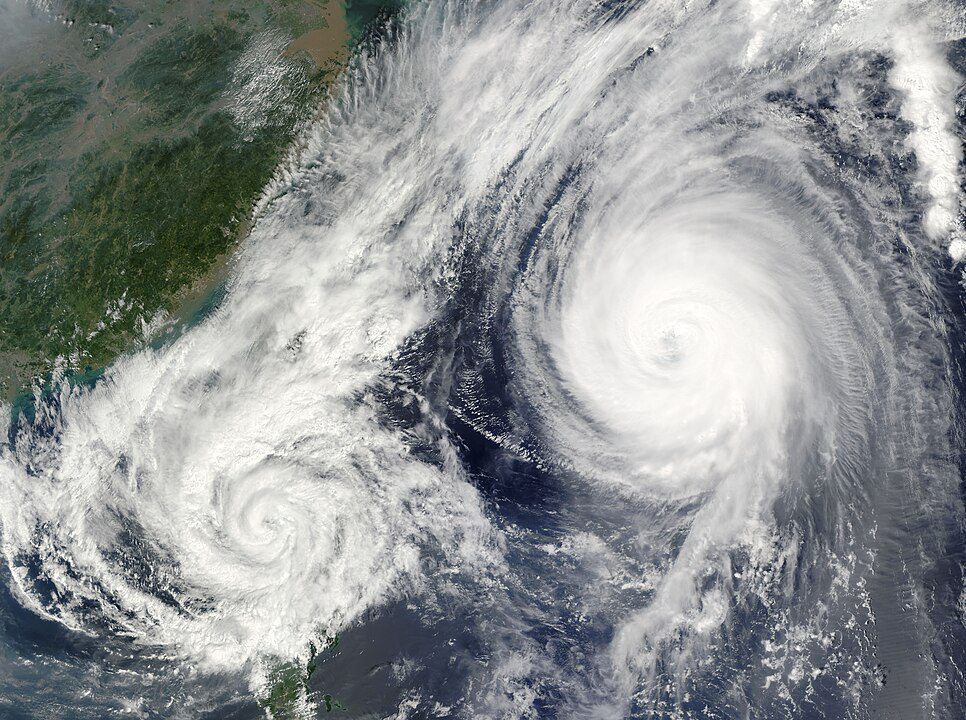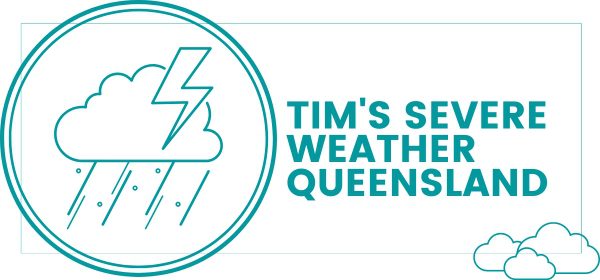Table of Contents
In the vast expanse of our atmosphere, the winds are in a perpetual dance, influenced by factors like friction, temperature, and the Earth’s rotation. Among these intricate movements, tropical cyclones stand out as some of the most powerful and dynamic systems. But what happens when these colossal storms cross paths?
Ten Facts About the Fujiwhara Effect
- Origin: The Fujiwhara effect is named after Sakuhei Fujiwhara, a Japanese meteorologist who first described it in 1921.
- Interaction: It occurs when two nearby cyclonic vortices, such as tropical cyclones or extratropical cyclones, interact with each other.
- Direction: In the Northern Hemisphere, the vortices orbit each other counterclockwise, while in the Southern Hemisphere, they orbit clockwise.
- Distance: For tropical cyclones, the effect becomes noticeable within 1400 km, and merger often occurs within 300 km.
- Outcome: The vortices can either merge into a single system or merely spin each other around for a while before moving on separate paths.
- Rare Phenomenon: The Fujiwhara effect is relatively rare and depends on factors like the size, distance, and atmospheric conditions of the vortices.
- Meteorological Impact: It can significantly change the track and intensity of cyclones, making forecasting their paths challenging.
- Other Occurrences: The Fujiwhara effect also occurs with other rotating fluid bodies like eddies in creeks or bathtubs and even on planets like Jupiter.
- Observations: The effect has been observed in various instances, including Tropical Cyclone Seroja and Tropical Cyclone Odette off Western Australia in April 2021.
- Scientific Study: Recent studies have focused on three-dimensional aspects of the Fujiwhara effect for binary tropical cyclones in specific regions like the western North Pacific.
The Nature of Tropical Cyclones
Tropical cyclones are formidable low-pressure systems that originate over warm, tropical waters. Fueled by the moist environment, they intensify, drawing more winds into their core. These storms can persist for days or even weeks over the open ocean, and their paths are often unpredictable. While they typically travel alone, occasionally, two cyclones will encounter each other, leading to a fascinating phenomenon known as the Fujiwhara effect.
Understanding the Fujiwhara Effect
When two cyclones approach each other, they begin to orbit around a common centre, akin to a celestial dance. This interaction, named after Japanese meteorologist Sakuhei Fujiwhara, causes the cyclones to rotate around each other in a clockwise fashion in the Southern Hemisphere. Despite their relative sizes, the larger cyclone tends to dominate, influencing the smaller one’s movement. As they draw closer, their paths can change dramatically, sometimes by as much as 90 degrees, as they are drawn towards each other.
If the cyclones move within 300 kilometres of each other, they may even merge, forming a single, larger cyclone. Alternatively, if they drift too far apart, they regain their independence, continuing their original paths. However, for the Fujiwhara effect to occur, the cyclones must be within approximately 1400 kilometres of each other, making these interactions relatively rare.
Beyond Tropical Cyclones: The Widespread Influence of the Fujiwhara Effect
While most commonly observed in tropical cyclones, the Fujiwhara effect is not limited to these storms. Fujiwhara’s original studies also explored its effects on spinning water in tanks and canals. This phenomenon extends to storms in polar regions and even to smaller-scale eddies in local water bodies.
The impact of the Fujiwhara effect is not confined to our planet. Observations of Jupiter’s vibrant bands and spirals reveal similar interactions, as well as predictions for the future collision between our Milky Way galaxy and the larger Andromeda galaxy.
Implications for Cyclone Forecasting
The Fujiwhara effect adds a layer of complexity to forecasting cyclone tracks and intensities. Meteorologists must consider the possibility of these interactions when predicting how cyclones will move and develop. This “tug of war” between cyclones underscores the dynamic nature of these storms and the challenges inherent in forecasting their behaviour.
In conclusion, the Fujiwhara effect highlights the intricate interactions within Earth’s atmosphere and beyond. As we continue to study and understand these phenomena, we gain valuable insights into the forces that shape our weather and climate.

Typhoon Parma (left) and Melor (right) interacting with each other in the Philippine Sea on October 6, 2009. – By NASA image courtesy the MODIS Rapid Response Team at NASA GSFC. Caption by Holli Riebeek. – http://earthobservatory.nasa.gov/NaturalHazards/view.php?id=40615(direct link), Public Domain, https://commons.wikimedia.org/w/index.php?curid=8000785
FAQ
Q: What is the Fujiwhara effect?
A: The Fujiwhara effect is a phenomenon where two nearby cyclonic vortices, such as tropical cyclones, interact with each other, causing them to orbit each other.
Q: How do cyclones interact during the Fujiwhara effect?
A: The cyclones rotate around a common centre, with the larger vortex often dominating the interaction and influencing the smaller vortex’s movement.
Q: Can cyclones merge during the Fujiwhara effect?
A: Yes, if the cyclones are within a certain distance of each other, typically 300 km for tropical cyclones, they may merge to form a single, larger cyclone.
Q: Does the Fujiwhara effect impact cyclone forecasting?
A: Yes, the interaction between cyclones can significantly change their paths, making it challenging for meteorologists to predict their movements accurately.
Q: How rare is the Fujiwhara effect?
A: The Fujiwhara effect is relatively rare and depends on various factors like the size and distance between the cyclones.
Q: Are there any real-world examples of the Fujiwhara effect?
A: Yes, recent examples include Tropical Cyclone Seroja and Tropical Cyclone Odette off Western Australia in April 2021.
Q: Does the Fujiwhara effect occur in both hemispheres?
A: Yes, but the direction of the cyclonic rotation differs between the Northern and Southern Hemispheres.
Q: Are there any studies on the Fujiwhara effect?
A: Yes, recent studies have focused on the three-dimensional aspects of the Fujiwhara effect for binary tropical cyclones in specific regions like the western North Pacific.
Advice & Actionable Tips
- Pay attention to weather forecasts and updates, especially during cyclone season.
- Be prepared for changes in cyclone tracks and intensities due to the Fujiwhara effect.
- Follow the advice and instructions of local authorities regarding cyclone preparedness and evacuation procedures.
🌐 Article Sources & Resources
- Bureau of Meteorology – When cyclones collide: the Fujiwhara effect
- AusStormScience – The Fujiwhara Effect
- ABC News – Two looming cyclones off WA set to create rare weather phenomenon known as Fujiwhara Effect
- The Conversation – Cyclone Seroja just demolished parts of WA – and our warming world will bring more of the same
- Wikipedia – Fujiwhara effect


